Motorola Droid 3 Review - Third Time's a Charm
by Brian Klug on July 30, 2011 12:01 AM ESTCellular Connectivity
So the elephant in the room is cellular connectivity on the Droid 3. To many people’s chagrin, the Droid 3 lacks 4G LTE connectivity, instead including dual-mode CDMA2000 1x/EVDO Rev.A and GSM/WCDMA compatibility with a Qualcomm MDM6600. We’ve seen Motorola using the MDM6600 in a host of smartphones lately, and the baseband offers a native dual-mode (world phone) solution that’s essentially fully realized in the Droid 3. To that extent, the Droid 3 does build and improve upon the connectivity of the Droid 2, but still doesn’t offer 4G LTE connectivity which would require an additional baseband and possibly larger package.
| Motorola Droid 3 - Network Support | |||||
| CDMA2000 1xRTT/EVDO Rev.A | 800 / 1900 MHz | ||||
| GSM/EDGE | 850 / 900 / 1800 / 1900 MHz | ||||
| WCDMA/UMTS | 850 / 1900 / 2100 | ||||
| HSPA Speed | HSDPA 10.2/14.4 (UE Cat. 9/10), HSUPA 5.76 | ||||
| Baseband | Qualcomm MDM6600 | ||||
We’ve already tested Verizon Wireless’s EVDO Rev.A considerably, but I ran 243 more tests on the Droid 3 and made a histogram again to show how things fare. Again we test using the speedtest.net application in real world environments at all signal levels and times of day to get a good picture for what real-world speeds look like. MDM6600 remains a competent CDMA2000 baseband.

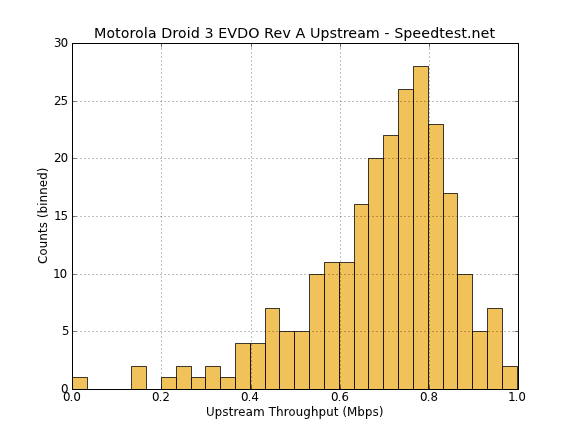
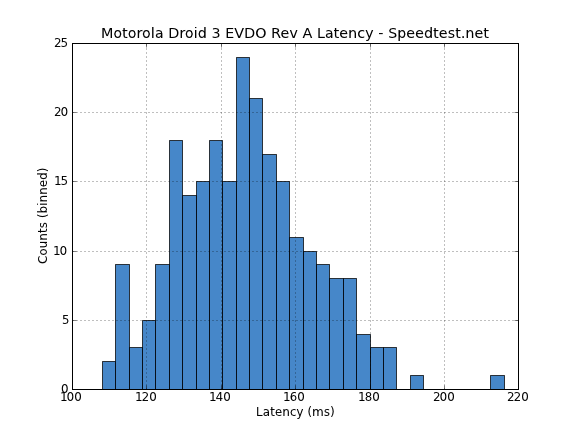
The obvious next part of the story is that WCDMA HSPA+ 14.4 Mbps connectivity. Unfortunately, Verizon has locked the retail Droid 3 out of seeing USA-based GSM/WCDMA networks with an MCC (Mobile Country Code) lock, so you’re out of luck if you want to use a retail Droid 3 on AT&T 3G (which it has the band support for) or T-Mobile 2G. Calling up Verizon and getting an unlock code doesn’t disable the MCC lock, but you can use the Droid 3 abroad that way. There’s another similar Droid 3 for sale outside normal retail channels that purports to have the MCC lock removed, but as we didn’t have one, I was unable to test any of the GSM/WCDMA connectivity on the Droid 3. It is there however, as evidenced by toggles in the wireless connectivity pages inside settings.
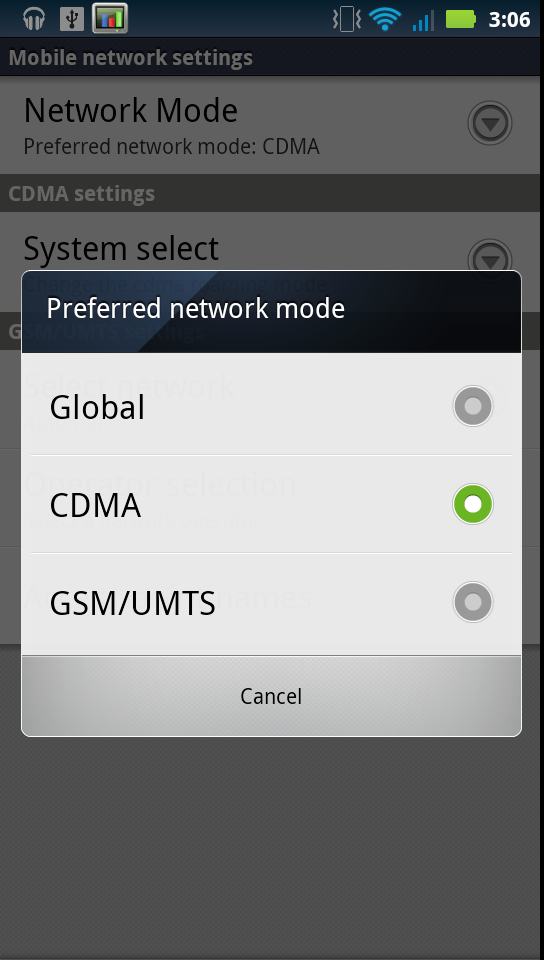
Next up is attenuation, which again we test for by holding the phone in a variety of positions and watching received signal strength move around. The Droid 3 (like all of its earlier CDMA2000 brethren) has Rx diversity, which you can additionally verify from inside the programming menu. I saw signal drop by 16 dB with the phone cupped at the top and bottom completely, which is about where we have seen other phones sit.
| Signal Attenuation Comparison in dB - Lower is Better | ||||||||
| Cupping Tightly | Holding Naturally | Holding in Case | On an Open Palm | |||||
| Droid 3 | 16.0 | 11.3 | - | 5.0 | ||||
| HTC Sensation | 15.0 | 10.0 | 8.0 | 0.0 | ||||
| Samsung Droid Charge | 10.0 | 10.0 | 5.0 | 0.0 | ||||
| HTC Thunderbolt - LTE | 5.3 | 2.5 | - | 4.4 | ||||
| HTC THunderbolt - EVDO | 6.5 | 0.8 | - | 7.2 | ||||
| Verizon iPhone 4 | 16.5 | 15.5 | 9.0 | 7.9 | ||||
| LG Optimus 2X | 13.7 | 9.3 | - | 5.9 | ||||
| Nexus S | 13.3 | 6.1 | - | 4.3 | ||||
| Droid 2 | 11.5 | 5.1 | - | 4.5 | ||||
| BlackBerry Torch | 15.9 | 7.1 | - | 3.7 | ||||
| Dell Streak | 14.0 | 8.7 | - | 4.0 | ||||
| Droid X | 15.0 | 5.1 | - | 4.5 | ||||
| AT&T iPhone 4 | 24.6 | 19.8 | 7.2 | 9.2 | ||||
| iPhone 3GS | 14.3 | 1.9 | 3.2 | 0.2 | ||||
| HTC Nexus One | 17.7 | 10.7 | 7.7 | 6.7 | ||||
One more thing to note is that the Droid 3 actually reports its signal strength bar visualization based on SNR instead of just receive power. I’ve read a few reports where people were confused by the lack of bars with the Droid 3 next to another Verizon Wireless device, and this is the reason. Remember that great signal strength and great SNR (which actually matters) are not necessarily mutually inclusive.
WLAN and Bluetooth
Next up is WiFi and Bluetooth, both of which are handled by the Droid 3’s onboard TI Wilink7 series TI1281 combo BT, FM, WLAN, GPS single chip solution. Note that the official Verizon specifications list TI1285 (which doesn’t exist yet on the TI website) but the actual Droid 3 ROM contains the necessary WLAN firmware for TI1281 client and AP mode in no uncertain terms. Either way, we at least know it's a Wilink 7 series stack. TI1281 supports 802.11a/b/g/n single spatial stream, however the Droid 3 doesn’t incorporate the appropriate 5 GHz front end for 802.11a/n, rather just 2.4 GHz 802.11b/g/n is supported. Likewise included is Bluetooth 3.0 and Low Energy (4.0) support, and GPS which the Droid 3 uses.

WLAN range on the Droid 3 is very good, with it being possible to use the Droid 3 in a few environments that the Droid 2 and X aren’t entirely stable in. I took a photo of the Droid 3 alongside the X I have borrowed from a friend with the Droid 3 showing -84 dBm of signal compared to the X’s -92 dBm.
I’m not entirely convinced that either are showing the proper link rate (65 Mbps seems odd considering the low signal), however I’ve been able to maintain connectivity throughout my test location. I’ve seen bursts of above 30 Mbps on the Droid 3 when doing our local PDF transfer test, however the average settled down to around 27 Mbps as shown in the graph below.
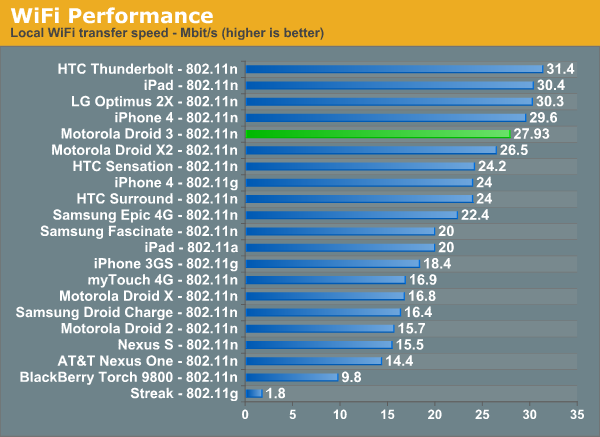
I guess that brings me to GPS on the Droid 3, which as I mentioned before is using the stack on the TI1281 instead of the stack on MDM6600. It acquires a 3D fix insanely fast, almost instantaneously. I timed under a second outside with no WiFi assist, down to 9.1 feet of accuracy almost immediately. I’m very impressed with GPS performance on the Droid 3. The only caveat is that it seems the TI1281 isn’t passing on NMEA GPS data which includes per-satellite SNR and position to the Android API. Instead, you just get a location and degree of precision measure, which makes it hard to know whether there’s some trickery going on or the GPS is really just that good.
The other interesting curiosity is that the Droid 3 is one of the first I’ve seen to list sGPS as a supported feature. The s in sGPS of course stands for simultaneous, which means that during E911 calls the GPS and voice data aren’t just slotted in a time multiplexed scheme but truly simultaneous.


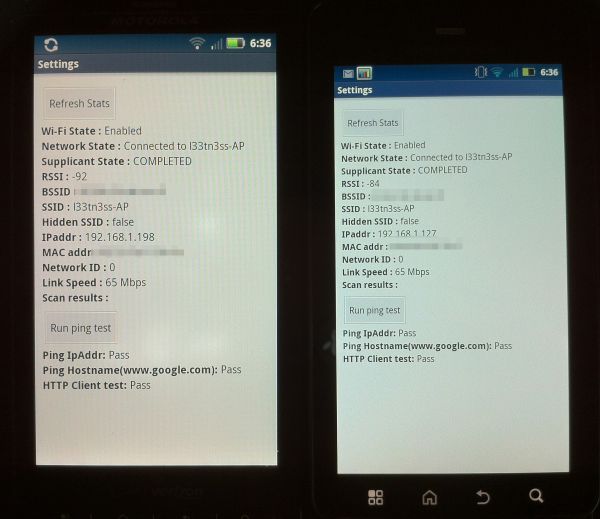









84 Comments
View All Comments
EndlessChris - Saturday, July 30, 2011 - link
Great review as always. Looks like this will be my new phone :)RaistlinZ - Saturday, July 30, 2011 - link
Sharp lookin' phone. I like.vol7ron - Sunday, July 31, 2011 - link
I like this too, larger screen, nice looking keyboard, great looking device. It seems to have it all.One thing, does it really have a 0.3MP front-facing camera? I would suspect 1.3MP would be more realistic, especially since there are probably economies of scale for that technology right now.
Thx,
vol7ron
Brian Klug - Friday, August 5, 2011 - link
Vol7ron,It definitely does have a 0.3 MP (VGA) front facing camera. http://developer.motorola.com/products/droid-3-xt8...
I'd like to see 1.3 MP sensors on the front for sure, but at this point it doesn't make sense until both the per-pixel quality is the same (same size pixels) and there are apps that can actually do some HD teleconferencing (like if Skype had support). We're almost there though.
-Brian
Myrandex - Monday, August 1, 2011 - link
It would be for me if it wasn't for this bastardization that Verizon did:The obvious next part of the story is that WCDMA HSPA+ 14.4 Mbps connectivity. Unfortunately, Verizon has locked the retail Droid 3 out of seeing USA-based GSM/WCDMA networks with an MCC (Mobile Country Code) lock.
Why can't Verizon just allow the hardware to perform at its fullest rather than finding some way to lock it down? They have always been terrible about locking their phones in some way.
Jason Cook
themossie - Saturday, July 30, 2011 - link
Tried the Droid 3 in store the day it came out, mixed feelings about the screen.Found it very usable for applications, not usable for serious reading (news, ebooks, etc). First time I've suffered eyestrain from an LCD screen with decent brightness and contrast. Droid 1 works great for this use case.
Brian, Anand and the rest of the AnandTech team - any opinions on this? Anyone else?
themossie - Saturday, July 30, 2011 - link
Also, thanks for the great review - business as usual at Anandtech!steven75 - Saturday, July 30, 2011 - link
Indeed. Can't believe he tried to equate this pentile display with less resolution in a larger screen size (significantly worse PPI) with the retina display. They aren't even close.bplewis24 - Saturday, July 30, 2011 - link
I'll trust the guy who looks at hundreds of phones per year over the hyperbolic masses who troll the internet.I'll also trust my own eyes and science, which prove you wrong.
Finraziel - Sunday, July 31, 2011 - link
Well, I'll also trust my own eyes, and the picture right above where Brian says he doesn't mind pentile too much really makes the droid3's screen look like crap compared to the lower resolution droid2 right next to it. My experience with other pentile screens also suggests there's absolutely no point in increasing the resolution only by using a trick like this, you end up with noticably lower effective resolution. I'd prefer an actually sharp screen over impressive specifications.I really hope when the 720p screen phones come out in the next half year or so they wont be using cheap tricks like this.